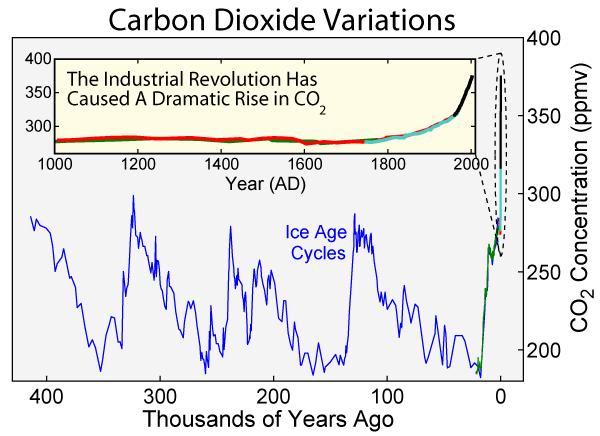There is a lot of carbon under that ice.
Potential methane reservoirs beneath Antarctica Wadham et al (2012)
Abstract: Once thought to be devoid of life, the ice-covered parts of Antarctica are now known to be a reservoir of metabolically active microbial cells and organic carbon1. The potential for methanogenic archaea to support the degradation of organic carbon to methane beneath the ice, however, has not yet been evaluated. Large sedimentary basins containing marine sequences up to 14 kilometres thick2 and an estimated 21,000 petagrams (1 Pg equals 1015 g) of organic carbon are buried beneath the Antarctic Ice Sheet. No data exist for rates of methanogenesis in sub-Antarctic marine sediments. Here we present experimental data from other subglacial environments that demonstrate the potential for overridden organic matter beneath glacial systems to produce methane. We also numerically simulate the accumulation of methane in Antarctic sedimentary basins using an established one-dimensional hydrate model3 and show that pressure/temperature conditions favour methane hydrate formation down to sediment depths of about 300 metres in West Antarctica and 700 metres in East Antarctica. Our results demonstrate the potential for methane hydrate accumulation in Antarctic sedimentary basins, where the total inventory depends on rates of organic carbon degradation and conditions at the ice-sheet bed. We calculate that the sub-Antarctic hydrate inventory could be of the same order of magnitude as that of recent estimates made for Arctic permafrost. Our findings suggest that the Antarctic Ice Sheet may be a neglected but important component of the global methane budget, with the potential to act as a positive feedback on climate warming during ice-sheet wastage.
That ice is melting faster than we thought it would.
Dynamics of the last glacial maximum Antarctic ice-sheet and its response to ocean forcing -- Fogwill et al (2012)
Abstract: Retreat of the Last Glacial Maximum (LGM) Antarctic ice sheet is thought to have been initiated by changes in ocean heat and eustatic sea level propagated from the Northern Hemisphere (NH) as northern ice sheets melted under rising atmospheric temperatures. The extent to which spatial variability in ice dynamics may have modulated the resultant pattern and timing of decay of the Antarctic ice sheet has so far received little attention, however, despite the growing recognition that dynamic effects account for a sizeable proportion of mass-balance changes observed in modern ice sheets. Here we use a 5-km resolution whole-continent numerical ice-sheet model to assess whether differences in the mechanisms governing ice sheet flow could account for discrepancies between geochronological studies in different parts of the continent. We first simulate the geometry and flow characteristics of an equilibrium LGM ice sheet, using pan-Antarctic terrestrial and marine geological data for constraint, then perturb the system with sea level and ocean heat flux increases to investigate ice-sheet vulnerability. Our results identify that fast-flowing glaciers in the eastern Weddell Sea, the Amundsen Sea, central Ross Sea, and in the Amery Trough respond most rapidly to ocean forcings, in agreement with empirical data. Most significantly, we find that although ocean warming and sea-level rise bring about mainly localized glacier acceleration, concomitant drawdown of ice from neighboring areas leads to widespread thinning of entire glacier catchments—a discovery that has important ramifications for the dynamic changes presently being observed in modern ice sheets.
When that ice melted previously, global carbon dioxide levels rose dramatically over only two hundred years.
Abrupt change in atmospheric CO2 during the last ice age – Ahn et al. (2012)Comment: This is all very new science, but these three very different papers with different subjects and different methods seem together to suggest a coherent narrative; ocean warming rapidly triggers widespread decay of the Antarctic ice sheets, which uncovers significant amount of carbon. That carbon makes its way into the atmosphere, in amounts significant enough to warm the climate further.
Abstract: “During the last glacial period atmospheric carbon dioxide and temperature in Antarctica varied in a similar fashion on millennial time scales, but previous work indicates that these changes were gradual. In a detailed analysis of one event we now find that approximately half of the CO2 increase that occurred during the 1500-year cold period between Dansgaard-Oeschger (DO) events 8 and 9 happened rapidly, over less than two centuries. This rise in CO2 was synchronous with, or slightly later than, a rapid increase of Antarctic temperature inferred from stable isotopes.”
Citation: Ahn, J., E. Brook, A. Schmittner, and K. J. Kreutz (2012), Abrupt change in atmospheric CO2 during the last ice age, Geophys. Res. Lett., doi:10.1029/2012GL053018.
The Arctic permafrost feedback appears (to an outsider, like me) to be gaining widespread acceptance as a significant contributor to global warming both in the near term (the next century) and in the longer term (a few centuries.) Now we are trying to nail down the scale of the feedback. Meanwhile, we are starting to get some science that suggests a similar carbon-cycle feedback could unfold in the South, scale and speed unknown.









